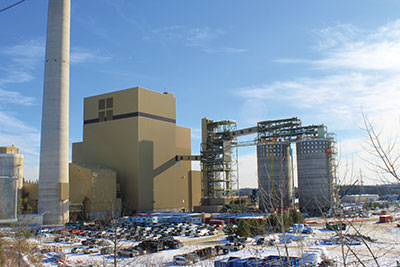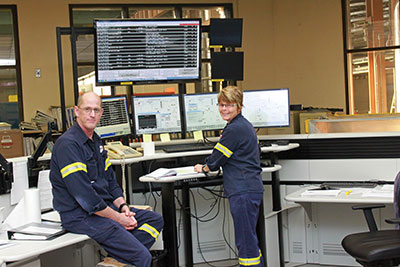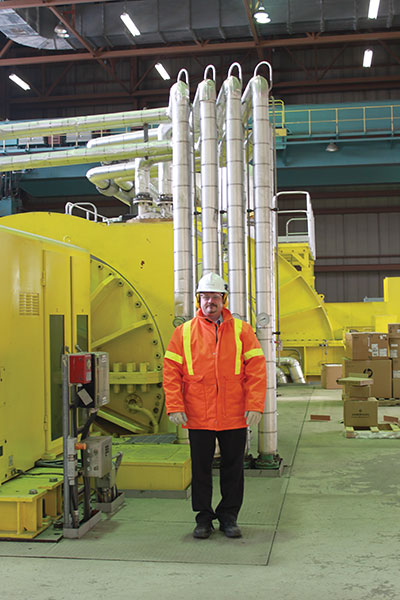
Localized biomass power sets Atikokan buzzing
February 11, 2014
By
Amie Silverwood
In the canoeing capital of Canada, the previously quiet town of Atikokan in Northwestern Ontario, residents are waking up to the bustling clang of construction and economic progress.
In the canoeing capital of Canada, the previously quiet town of Atikokan in Northwestern Ontario, residents are waking up to the bustling clang of construction and economic progress. This winter, the local hotel is booked, restaurants are busy and the whole town is buzzing with activity. The local generating station was the last of Ontario’s coal-fired stations built in 1985, and with the provincial government’s announcement that it would no longer use coal for energy production, the Atikokan Generating Station embarked on a first-of-its-kind conversion to biomass.
 |
|
| The Atikokan Generating Station will fire up a few test runs early in the year with the first shipments coming from Rentech in the summer and Resolute Forest Products beginning to supply pellets in the fall.
|
The conversion has brought new life to the small community with 300 construction jobs as the facility went through a major overhaul to accommodate the new wood pellet feedstock. With this conversion, a new wood pellet plant is being built in town bringing plenty of work for contractors in the nearby boreal forest. Economic spinoffs reach further than the construction workers and tree harvesters: the generating station has stopped buying coal from Saskatchewan and shifted to local forest byproducts. The local pellet mills will provide additional revenue to sawmills and contribute to a more robust forest industry as a whole. The station requires 90,000 tonnes of pellets that will be supplied by Rentech (it purchased the Atikokan Renewable Fuels facility and the OPG contract to supply 45,000 tonnes) and Resolute Forest Products (45,000 tonnes).
“Had this facility not gone forward, we wouldn’t have had Atikokan Renewable Fuels building a facility and Resolute building a
facility in Thunder Bay to supply it. Those contracts dominoed with Rentech’s Wawa move and the contract to supply Drax as well. They’ve gone full-steam into pellet production because of one contract with us,” explains Brent Boyko, the director of business development for Atikokan Generating Station.
When Atikokan Generating Station first became serious about burning wood pellets in 2008, there were no local pellet manufacturers and very little local knowledge on the topic. But with some funding, researchers looked into whether there was enough wood to supply the power station, the cost of bringing in the new fuel and what it would require to convert. Test runs were done with different fuels, including wheat shorts and different kinds of pellets that were brought in from B.C.
Initial results were positive and trials progressed incrementally until a fire broke out in December 2008. The facility wasn’t running at the time and there were no injuries but it put a hold on the biomass conversion program to allow the team to regroup and understand the elements that contributed to the explosion. It was important to build in the necessary safety features to prevent similar incidents down the road.
“You need to respect it’s a fuel. Treat it accordingly and have procedures and mitigation devices in place,” says Boyko. “You want something with a high heat content and low moisture so it’s a catch-22. You want it to burn but you want it to burn in the boiler.”
When driving up to the updated facility, the most noticeable change is what appears to be two windowed silos connected to the building by a bridge. But these silos are more high-tech than the average grain silo.
 |
|
| OPG has put a lot of focus on health and safety elements of the conversion, monitoring the temperature of the pellets throughout the facility. The Atikokan Generating Station is approaching nine years without a loss-time accident.
|
“We’ve incorporated the best practices from around the world for wood pellet storage,” Boyko explains. The material handling equipment was designed by Aecon to both preserve the integrity of the pellets and keep them from heating up.
They will arrive at the generating station by truck from either Resolute’s Thunder Bay mill or the new Rentech Atikokan pellet mill. Resolute will make its pellets from sawmill residue and Rentech will use hardwood and other residual fibre.
“We’re in a mixed forest and traditionally there hasn’t been a lot of demand for the hardwoods in the Northwest so it’s been a bit of a conundrum for the harvesters,” says Boyko. “They have to take all the wood down to reforest it so there’s been a real inability to market that fibre previously.”
The self-unloading trucks will back onto a ramp, dump the pellets into a hopper and into a bucket elevator that gently delivers them into the silo. It will take about 15 minutes to unload a truck and they will be receiving 10 trucks a day at 35 tonnes each, five days a week.
“We felt we needed to preserve the integrity of the pellet as much as possible.” According to Boyko, the use of self-unloading trucks is a non-aggressive type of handling that keeps the pellet from breaking down during the transfer from the pellet mill to the generating station. “You’re coming from a short haul so there’s not a lot of double handling. It’s not getting beat up in a rail car that’s travelling thousands of kilometres.”
The feed conveyor gently drops the pellets onto a helical coil that runs down the length of the silo. “As the pellets come in, they slide down and it’s almost like a children’s slide,” he says.

|
|
| The fibre for the pellets and the pellets themselves are produced within 200 kilometres of the facility.
|
Gravity feeds them into the hopper at the bottom of the silos where their temperature is closely monitored. Aeration is built in: blowers can cool the pellets if they begin to self-heat with the option of suppressing any thermal events with nitrogen, if necessary. The idea is to keep the majority of the pellets in the silos that have been specially designed for dry storage, only transferring a small amount of fuel at a time into the bottom of the old coal bunkers within the plant. Safety always being top of mind, the coal bunkers have all been modified for fire suppression if they become too hot. Isolation valves can trap the fuel from above and below.
Now that the pellets are required for fuel, they must be de-pelletized. Boyko explains that the pulverizers previously used to pound the coal were modified for turning the pellets back into sawdust since they require less force than the very hard coal.
“All the modifications have been done with extensive benchmarking and research by Hitachi. They supplied the technology that informed the design changes,” he says.
Previously, five pulverizers acted like oversized mortars and pestles to grind the coal to dust, but the pellets require only one pass through the pulverizers to be returned to their native sawdust form so four were removed and replaced with explosive suppression.
Wood pellets have a low moisture content versus the 10 per cent found in coal so the pre-drying stage was eliminated from the process. Doosan Power Systems supplied the burners. They were able to replace the coal burners and slot into the same openings on the boiler and the system was fit with new igniters and scanners.
“The main focus of the project was making sure we got the right science and technology and the right folks out there that are doing this well.” Boyko says his team visited biomass generation stations in Europe to become familiar with the process, the challenges and best practices. “This is a first for OPG and will be the largest in North America so we wanted to make sure we did our homework and got the right partners.”
Now that the upgrades are almost complete, Boyko expects to be bringing in some pre-test fuel early this year. This will involve running pellets down the completed silos, around the bucket elevator, through the process and perhaps through the pulverizers. Rentech will be ready to supply in the middle of 2014 with Resolute adding its pellets in the fall.
In the meantime, Boyko is rightfully proud of OPG’s accomplishments in Atikokan and he’s happy to share his knowledge with others. “This facility is drawing a lot of attention,” he boasts. “We’ve conducted a number of tours and we anticipate hosting a lot more going forward simply because we’ll be the largest in North America.”
Thunder Bay gets the green light to test advanced biomass
Though power generation from wood pellets is still uncommon in the region, progress is coming. OPG has recently decided to do a trial with advanced biomass – either torrefied pellets or steam-treated biomass – in the Thunder Bay coal burning generation station. Since this project is in the experimental phase, being one of the first power plants in the world to replace coal with advanced biomass as its fuel, the goal is to produce about two per cent of the generator’s previous capacity or 15,000 tonnes a year for five years.
“The driver (at Thunder Bay) is to go with a low capital conversion cost that will meet the market needs when we are mandated to be off coal in 2014,” says Brent Boyko, director of business development for Atikokan Generating Station.
The advantage of the new generation of biomass is that they don’t take on moisture so they can be kept outdoors – making them easier to store. “They’re as coal-like as you can get with an engineered advanced biomass fuel.”
Print this page